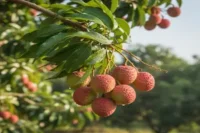Top 5 Carrot Growing Stages You Need to Know for Success
Published: 4 Mar 2025
Carrot is a very popular vegetable worldwide. They start growing from seed in 1 to 3 weeks, but this is just the start of their journey. After 2 to 4 months, they become ready to eat. Each stage of growing carrots is important, from planting to picking. Knowing how carrots grow helps farmers grow them well. Carrots grow best in warm soil, between 50°F and 85°F. They come in many colors, like red, white, and purple, not just orange.
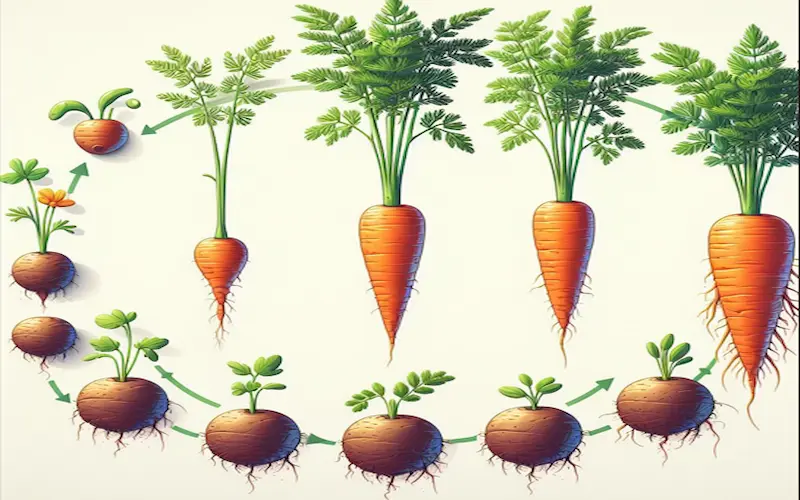
Key Takeaways
- Recognize the importance of the germination stage, which can last 1-3 weeks and sets the foundation for the carrot’s growth timeline.
- Carrots require varying periods to mature, generally between 2-4 months, depending on the variety.
- Optimal soil temperatures for growth range from 50°F to 85°F, with carrots favoring a slightly acidic to neutral pH level of 6.0 to 7.0 for peak development.
- Carrots thrive with appropriate space—about 2-3 inches between seedlings—to ensure adequate root expansion.
- Be aware of the array of carrot colors available, from the traditional orange to intriguing hues like red, white, and purple, which will add diversity to your garden.
- Proper watering and soil conditions are essential, as carrots do best with at least 1 inch of water per week and prosper in sandier soils.
- Companion planting with tomatoes can be a natural method to protect your carrot crop against pests like the carrot rust fly.
Planting Carrots
Starting to plant carrots means knowing what they need to grow well. The time it takes for carrot seeds to germinate is key. Getting this right can make your garden a success.
Choosing the Right Time and Soil for Planting
Carrots thrive in cool weather and well-drained soil. If you’re planting carrots in containers, make sure the soil is like their ideal home. They love sunny spots and do well in sandy or loamy soils that drain well.
The best time to plant is when the soil is between 55°F and 65°F. Depending on where you live, this is usually early spring or late summer.
Seed Viability and Selection
Choosing top-quality seeds is crucial for carrot success. Fresh seeds lead to better germination and healthier plants. They germinate best in soil that’s 55-65°F.
Seeds can take 14-21 days to pop up. Covering the seeds with a thin layer of compost helps them grow.
It’s key to start right with your planting. Make sure the soil is ready, and watch the seeds closely. This way, you can enjoy a great harvest of carrots.
Carrot Germination
Carrot germination is a key step in growing carrots. It starts when carrot seedlings first appear. This stage takes about 14 to 21 days after planting. It’s essential to keep the soil moist during this time.
The seeds are planted shallow, ¼ to ½ inches deep, in cool spring soil. In warmer, drier summers, they go ½ to ¾ inches deep.
At first, you’ll see two small leaves called cotyledons. They don’t look like carrot leaves but help the plant grow. Then, true leaves come out, looking feathery. This means the plants are growing strong, ready for big roots. These roots need less water before they’re picked to avoid breaking.
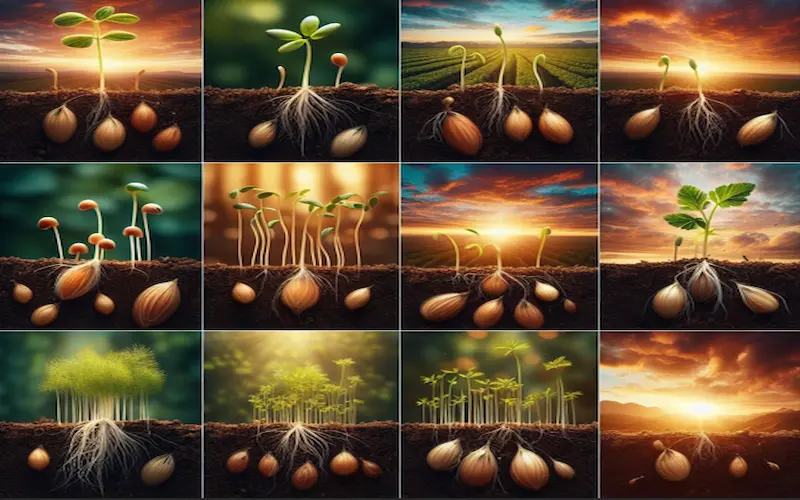
Planting radish seeds with carrots helps with growth. Radishes grow fast and mark the rows. They help spot carrot sprouts and keep the area weed-free.
- Make sure the soil stays moist but not too wet.
- Keep an eye on the moisture to stop the seeds from drying out.
- Thin the seedlings about two inches apart when they’re two inches tall. This stops them from fighting over food.
Carrot sprouts are not just for eating roots. Their greens can be used in salads or as garnishes. They add flavour and look nice in dishes. It’s key to tell them apart from weeds early on by looking at their leaves.
Watching your carrot seedlings grow is essential. With care, they will grow into a big harvest.
Recognizing the Carrot Growth Timeline
The journey from seed to harvest is exciting for gardeners. It shows how carrots grow from tiny seeds to tasty vegetables. We’ll look at the key stages of carrot growth, focusing on how they sprout and develop.
Understanding Carrot Development Process from Cotyledons to True Leaves
Carrots start with cotyledons, showing life about 1.5 to 3 weeks after planting. These early leaves help the seedling grow. Then, true leaves appear, looking like mature carrot leaves. This marks a significant step towards growing carrots.
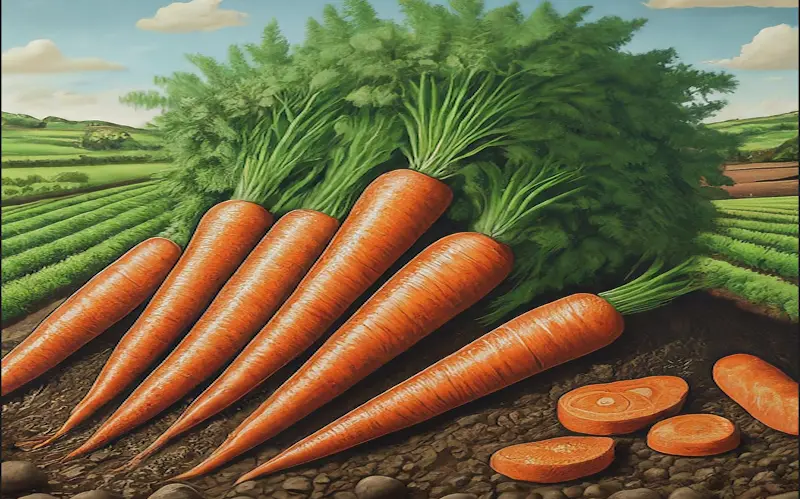
Temperature and Moisture’s Role in Carrot Sprouting
Temperature is key for carrot seeds to grow. They do best in soil that’s 55°F to 65°F. Soil should stay moist for healthy growth, taking about 14 to 21 days. Drip irrigation is great because it protects moisture, saves water, and fights diseases.
Early carrot growth needs careful attention. Keep the soil correct for temperature and moisture. This helps carrots sprout well and grow into tasty carrots. Every stage, from cotyledons to true leaves, is essential for a good crop.
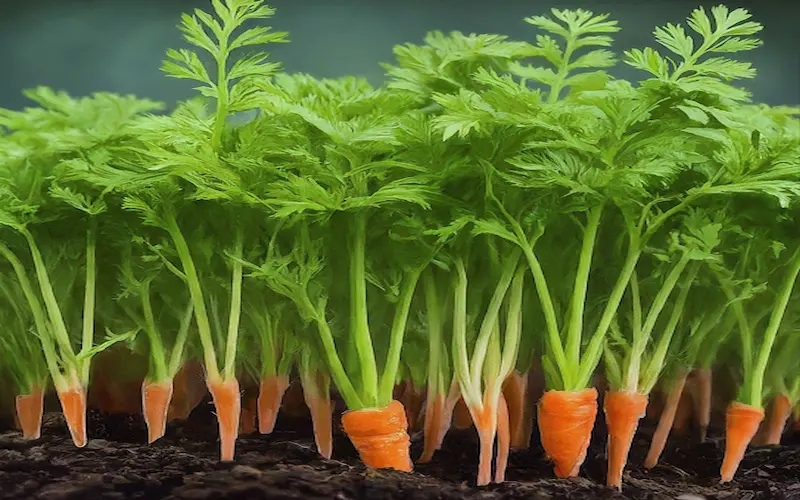
Thinning Carrot Seedlings: Encouraging Strong Roots
Starting with the right thinning of carrot sprouts is key. It lets your carrots grow big roots. This is important for lots of carrots. Early thinning helps by giving each plant enough food and water.
When you see the first green shoots, start thinning. Remove the small, weak ones to help the strong ones grow. As recommended, put seedlings 1-2 inches apart at first.
Later, they thin more as carrots grow. By a few inches tall, they should be half an inch apart for big roots.
Be gentle when thinning to avoid hurting the roots. Use a fork to remove seedlings carefully. This helps roots grow strong with enough space.
Don’t throw away thinned seedlings. They can be baby carrots. Enjoy their crisp taste and sweet flavor. Keep watering and taking care of your carrots for the best results.
Knowing how long carrots take to grow and their space needs is key. Thinning carefully helps carrots grow well, leading to a big harvest.
Follow these thinning tips for better carrot roots and a successful garden.
With patience and care, you can grow many healthy carrots. Every step, from planting to picking, is essential.
The Rapid Growth Phase of Carrots
When you start growing carrots from seed, knowing about the rapid growth phase is key. This stage sees significant changes in the plants’ size and health. It happens when they get the right growing conditions and care. How you take care of them now can affect your harvest’s quality and size.
Carrot Foliage Development and Care
Watching the carrot foliage is important for checking the plant’s health. Ensure your carrots get 6-8 hours of sunlight daily for strong growth. The best temperature for this is between 60°F and 75°F. Keeping these conditions helps the foliage grow well, which supports strong roots.
When fertilizing carrots, be careful not to overdo it. A balanced fertilizer about five weeks after planting helps the foliage grow big and healthy. Regular weeding ensures the carrots get all the nutrients and water they need, helping them grow well.
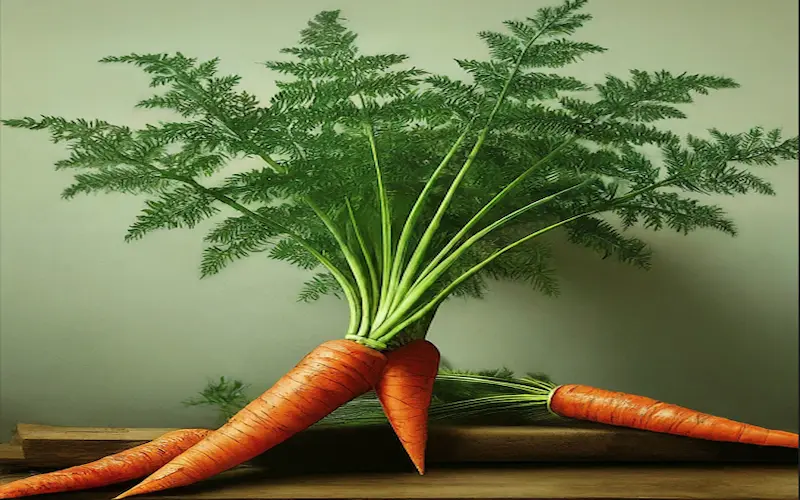
Importance of Soil Nutrients and Sunlight
Carrots do best in well-drained soil that’s rich in particular nutrients. The soil should be between 6.0 and 7.0 on the pH scale. It should also have lots of organic matter and stay moist. Carrots need about one inch of water every week. This keeps the soil from drying out, which is key for germination and root growth.
The soil’s depth also matters for carrot roots. They need at least 8 to 12 inches to grow well. Meeting these conditions can make your carrot crop more flavorful and bigger.
Keep an eye on your carrot plants as they grow fast. Taking good care of them now can lead to a big harvest of tasty carrots. You can enjoy them fresh from your garden or use them in many dishes.
| Growth Phase | Sunlight Hours | Water per Week | Optimal Soil pH |
|---|---|---|---|
| Rapid Growth | 6-8 hours | 1 inch | 6.0-7.0 |
Carrot Growing Stages
Gardeners must know how to grow carrots. Each step, from planting to picking, requires special care. Carrots do best in deep, loose soil that’s rich in nutrients.
When you plant carrot seeds, leave about 3/4 to 1 inch between them. This stops them from growing too close and needing thinning later. It also saves work and reduces waste.
Watching the seeds grow is exciting. They usually start to sprout in 14-21 days. This is the start of a great carrot crop. Keeping the soil just right during this time is crucial. Too dry or too wet can hurt the seeds and the plants.
As the carrots grow, keeping the soil right is still key. Not enough water slows them down, and too much can cause problems. Also, weeding gently helps them grow strong. For the best results, leave about 2-3 inches between each carrot.
| Growth Stage | Duration | Required Conditions |
|---|---|---|
| Germination | 14-21 days | Even moisture, 1-3 weeks |
| Seedling | Up to 30 days | Moist soil, thinning at 2-3 inches apart |
| Mature growth | 50-80 days | Deep, fertile soil; regular weeding |
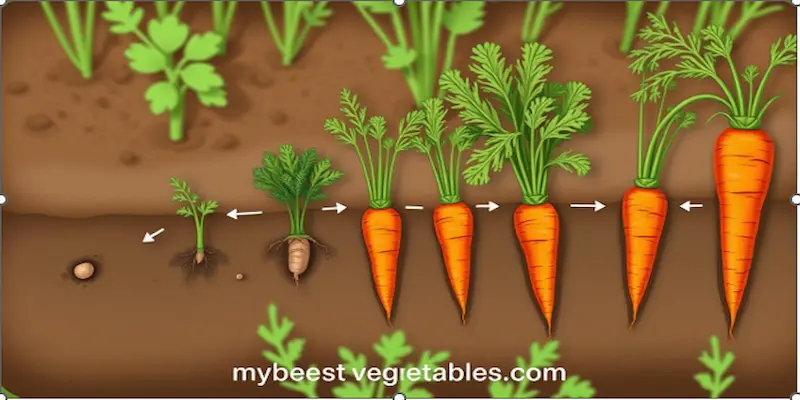
Whether you’re new or experienced, understanding carrots’ needs at each stage is essential. With the proper care, you can grow healthy, tasty carrots. The secret is consistent attention and knowing what they need.
Defending Against Pests and Diseases
When growing carrots, it’s key to keep them safe from pests and diseases. Knowing how carrots grow and how to protect them is vital. Using the right methods and acting fast keeps plants healthy and boosts carrot production.
Common Carrot Pests and Organic Control Methods
Pests can harm carrot growth, leading to less food. Carrots face many threats, like fungi and bacteria. But, you can fight back with organic ways like using clean seeds and rotating crops. Choosing seeds marked as disease-resistant also helps manage diseases.
Using row covers keeps bugs away and helps control the weather. This is good for fighting pests and diseases in carrots. Adding good stuff to your soil makes plants stronger against pests.
Identifying and Treating Carrot Diseases
Carrots are threatened by fungi, bacteria, nematodes, and viruses. Catching problems early prevents them from getting worse. Keeping the soil healthy also helps a lot. Mulching and smart watering, like drip irrigation, cut down on diseases.
Keeping the soil’s pH and giving it the right food helps fight diseases and grow healthy carrots.
Using these tips will help you fight pests and diseases better. Keep an eye on your carrots for any problems. Catching issues early makes them easier to fix, letting your carrots grow well.
When to Harvest Carrots
Knowing when to harvest carrots is key to a tasty and tender crop. Depending on the type and growing conditions, carrots take about two to four months to grow. The carrot harvest timeline changes, but some signs show when they’re ready.
Start checking for readiness when carrots push up from the soil. The tops show above the soil. Carrots should be about half an inch thick. They get too big and tough if left in the ground too long.
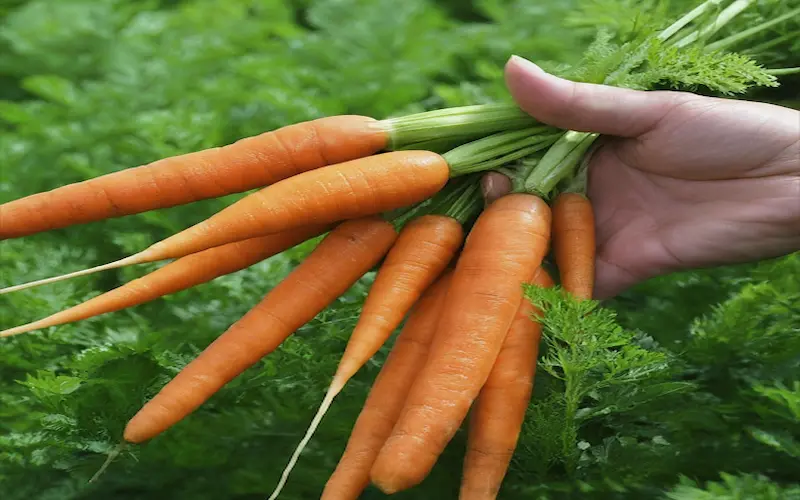
The best time to harvest depends on the weather during growth. Carrots taste best after a frost. They should be firm and crisp. If it is too hot or dry, carrots may mature quickly, so harvest them sooner.
To find the best carrot harvest timeline, check the size and taste of a few carrots. Remove one or two from the soil. If they’re small but sweet and crisp, it’s time to harvest.
To prevent carrot problems, keep the soil moist and avoid too much nitrogen. Thin your carrots early to prevent them from growing too close together. This helps them grow big and healthy.
Following these tips will help you determine the best time to harvest carrots, ensuring they are tasty and healthy. The exact timing depends on the carrot type, local weather, and how you grow them.
Extending the Harvest: Storing and Preserving Carrots
Knowing how to store carrots after they’ve grown is key. This keeps them fresh and tasty. The way you move carrots from the garden to storage is very important.
Proper Techniques for Harvesting Carrots
It’s important to harvest carrots correctly. Make sure the soil is soft so you don’t hurt the carrots. Carrots should be pulled when the soil is dry to avoid spoilage.
When pulling carrots out, support the base of the greens to avoid damage. After pulling, cut the carrot plant leaves short to keep the roots moist and prevent the greens from drying out the carrots.
Storage Conditions for Prolonging Freshness
The right storage is essential for keeping carrots fresh. Clean and trim the carrots before storing them. Store them in a cool, moist place, just above freezing.
This keeps the carrots from breathing too much and losing flavour. Here are some tips for storing carrots:
- Refrigeration in bags with holes helps keep moisture in.
- Layered carrots in moist sand or peat also work well.
- Check for any bad carrots and remove them to keep the rest fresh.
You can leave carrots in the ground for winter and cover them with mulch. This protects them from the cold. Carrots get sweeter after a few frosts, which is great for gardeners in cold areas.
Using the best methods to harvest and store carrots means your garden work pays off. Keeping your carrots fresh and usable improves your cooking. This vegetable is both tasty and good for you.
Faqs related Carrot Growing Stages.
Carrots take 60 to 80 days to grow, depending on the variety and growing conditions. Some baby carrot varieties can be harvested as early as 30 to 50 days, while larger varieties may take longer.
Carrot Growth Stages:
- Germination (7-21 days): Seeds sprout and small leaves appear.
- Seedling Stage (2-4 weeks): Roots start developing, and the first true leaves grow.
- Root Development (4-6 weeks): The carrot begins forming underground.
Maturity (60-80 days): The carrot is fully grown and ready for harvest.
Step 1: Choose the Right Location
- Pick a sunny spot with loose, well-drained soil to allow roots to grow straight.
- Avoid rocky soil, as it can cause deformed carrots.
Step 2: Prepare the Soil
- Loosen the soil at least 12 inches deep.
- Remove weeds, rocks, and debris.
- Mix in compost or organic matter to improve soil quality.
Step 3: Plant the Seeds
- Sow seeds ¼ inch deep and 1 inch apart in rows.
- Space rows 12 inches apart for proper growth.
- Lightly cover with soil and gently press down.
Step 4: Watering and Care
- Keep the soil moist but not soggy to help seeds sprout.
- Thin seedlings to 2-3 inches apart once they grow 2 inches tall.
Step 5: Mulching and Weeding
- Apply a thin layer of mulch to retain moisture.
- Remove weeds carefully to avoid disturbing the carrots.
Step 6: Harvesting Carrots
- Carrots are ready to harvest when they reach the desired size (usually after 60-80 days).
- Gently pull them out or loosen the soil first if needed.
No, carrots do not need daily watering. Instead, they require consistent, deep watering about 1 inch per week.
Best Watering Practices:
- Water 2-3 times weekly, allowing moisture to reach deep into the soil.
- Keep the soil moist but not waterlogged, as too much water can cause root rot.
- Use mulch to help retain moisture and reduce evaporation.
Carrots grow best in full sun but can tolerate partial shade.
Sunlight Requirements:
- 6-8 hours of direct sunlight daily for best growth.
- It can grow in partial shade but may take longer to mature.
Too much shade can lead to thin and weak roots.
Yes, dogs can safely eat carrots in moderation, and they’re a nutritious, low-calorie treat packed with vitamins, fiber, and antioxidants. Below is a detailed, veterinarian-backed guide to feeding carrots to dogs, including benefits, preparation tips, and precautions to ensure your pet’s safety.
Are Carrots Safe for Dogs? Carrots are non-toxic to dogs and have been approved by the ASPCA as a safe snack. Raw and cooked carrots (without additives like salt, butter, or spices) are acceptable. However, always cut carrots into bite-sized pieces to prevent choking, especially for small breeds. Health Benefits of Carrots for Dogs
- Dental Health: Crunching raw carrots helps scrape plaque off dogs’ teeth.
- Rich in Nutrients: Carrots are high in beta-carotene (converted to vitamin A), which supports eye health, skin, and coat.
- Low-Calorie Treat: Ideal for weight management—a medium carrot contains only ~25 calories.
Digestive Support: The fiber in carrots aids digestion and promotes gut health. How to Safely Feed Carrots to Dogs
- Raw Carrots: Wash thoroughly, peel (optional), and slice into sticks or small chunks.
- Cooked Carrots: Steam or boil plain carrots until soft for easier digestion (avoid oils or seasonings).
- Frozen Carrots: A soothing treat for teething puppies.
- Portion Control: Limit to 1–2 baby carrots or ¼ cup of chopped carrots daily, depending on your dog’s size.
Avoid:
Overfeeding, as excess vitamin A, can cause health issues.
Canned carrots (often high in sodium).
Carrot cakes or recipes with added sugar, raisins, or xylitol (toxic to dogs). Risks and Precautions
Allergies: Though rare, monitor for itching, vomiting, or diarrhea.
Choking Hazard: Whole carrots or large pieces can block airways. Always supervise your dog.
Stomach Upset: Introduce carrots slowly to avoid digestive issues.
Carrot seeds take 14 to 21 days to germinate. Soil conditions and temperature affect this time. Keep the soil moist for successful sprouting.
Conclusion
Understanding the carrot growing stages is key to cultivating crisp, sweet, and vibrant carrots right in your backyard. From sowing seeds to harvesting mature roots, each phase—germination, vegetative growth, root development, and maturation—plays a vital role in ensuring your crop thrives. By nurturing seedlings with consistent moisture, thinning plants to prevent overcrowding, and monitoring soil health during the critical root-bulking stage, you set the foundation for a successful harvest.

- Be Respectful
- Stay Relevant
- Stay Positive
- True Feedback
- Encourage Discussion
- Avoid Spamming
- No Fake News
- Don't Copy-Paste
- No Personal Attacks



- Be Respectful
- Stay Relevant
- Stay Positive
- True Feedback
- Encourage Discussion
- Avoid Spamming
- No Fake News
- Don't Copy-Paste
- No Personal Attacks



